- Books Name
- ACME SMART COACHING Biology Book
- Publication
- ACME SMART PUBLICATION
- Course
- CBSE Class 11
- Subject
- Biology
ANATOMY OF DlCOT AND MONOCOT PLANTS
Anatomy of Root
Anatomically, three zones can be distinguished in a root. These are:
(i) Epidermis. It is single layered (uniseriate) and consists of tightly placed, thin walled, uncutinised cells. This epidermis layer is called as epiblema or rhizodermis. Epiblema in younger roots bears unicellular root hairs (water absorbing organs), and is also called piliferous layer.
(ii) Cortex. It consists of thin walled parenchymatous cells with intercellular spaces. In most monocots and some dicots, the cortex layer below epidermis becomes suberised to form protective tissue called exodermis. The cells of cortex store food material (e.g., carrot). The innermost layer of cortex develops into endodermis. It is made up of closely packed living cells characterised by the presence of band like thickenings made of lignin and suberin on their radial and tangential walls. These bands or strips are called Casparian bands or strips. Some cells of endodermis lying opposite to protoxylem remain thin walled and are called passage cells which allow radial diffusion of water.
(iii) Vascular bundles. Vascular bundles are radial and exarch. The centre of monocot root is occupied by parenchymatous cells called pith.
Differences between dicot and monocot root

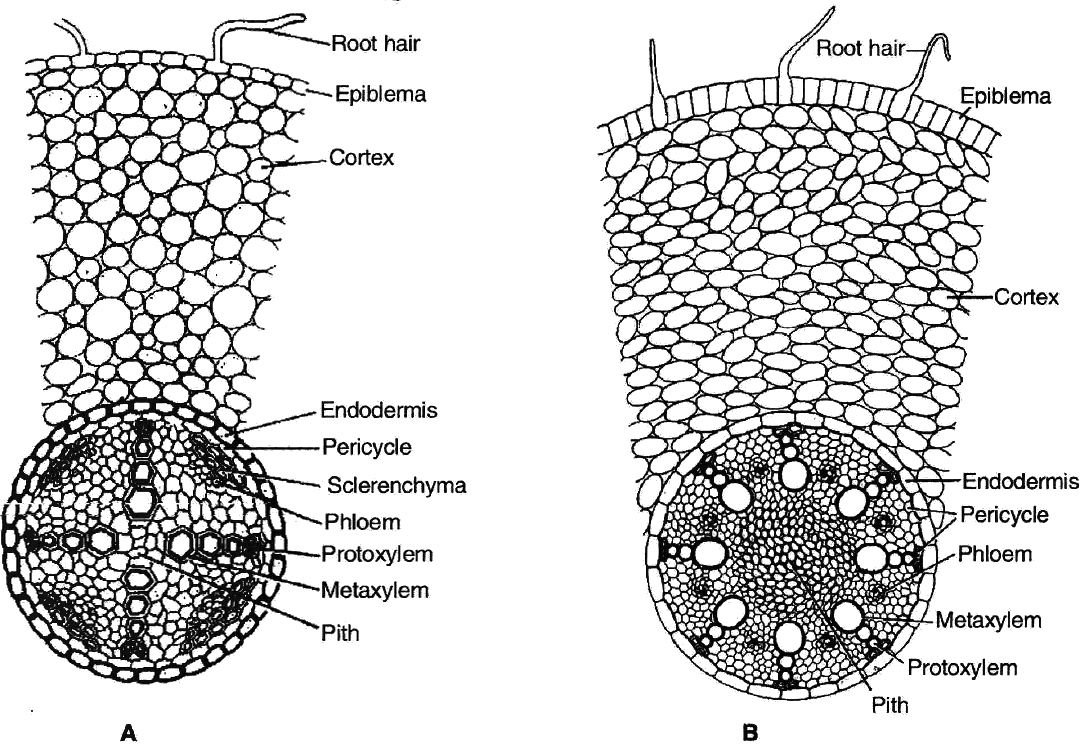
Anatomy of Stem
1. Primary structure of dicot stem
Dicot stem consists of following layers:
(i) Epidermis: It is the outermost layer consisting of single layer of closely arranged cells with cuticle (cutinized). It bears multicellular hairs.
(ii) Cortex: It is differentiated into hypodermis, general cortex and endodermis. Hypodermis is collenchymatous. General cortex is parenchymatous. Endodermis is wavy. It has starch grains hence it is called starch sheath or endodermoid.
(iii) Pericycle: It lies inner to endodermis. Pericycle is few layered thick. Above vascular bundle, it is sclerenchymatous and outside medullary rays it is parenchymatous.
(iv) Vascular bundles: These are in the form of a ring or eustele. They are conjoint, collateral and open. In the family Cucurbitaceae, the stem is wavy, having five ridges and five furrows and vascular bundles are present in ridges and furrows. Vascular bundles are bicollateral and open.
(v) Medullary or pith rays: These are radial strips of parenchyma present between adjacent vascular bundles. They help in radial conduction of food.
(vi) Pith : It is the central portion of stem consisting of parenchymatous cells with intercellular spaces. Narrow, radially elongated parenchymatous cells extend from pith toward the periphery are called medullary rays. The main function is food storage.
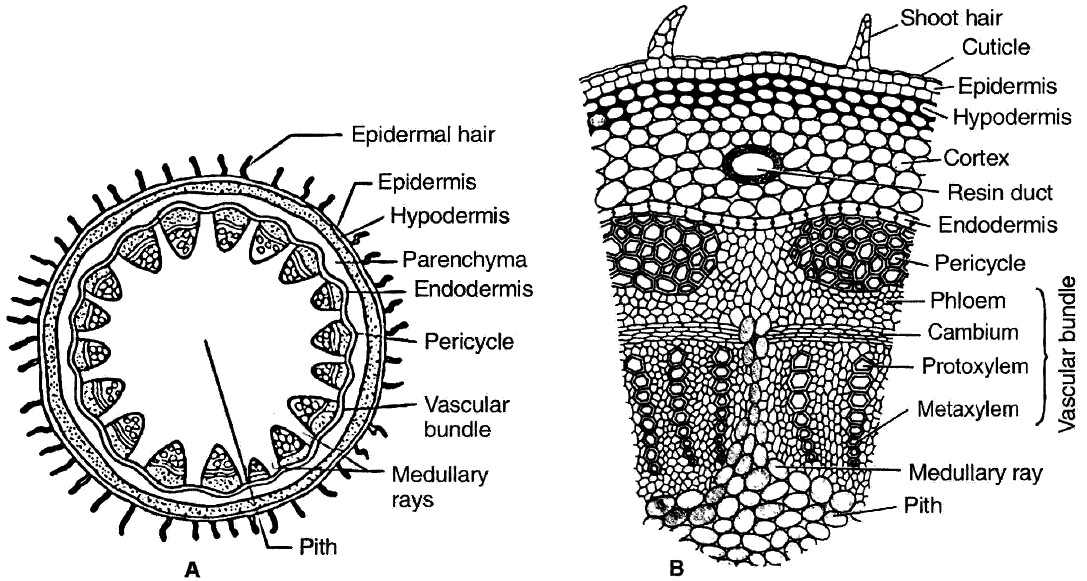
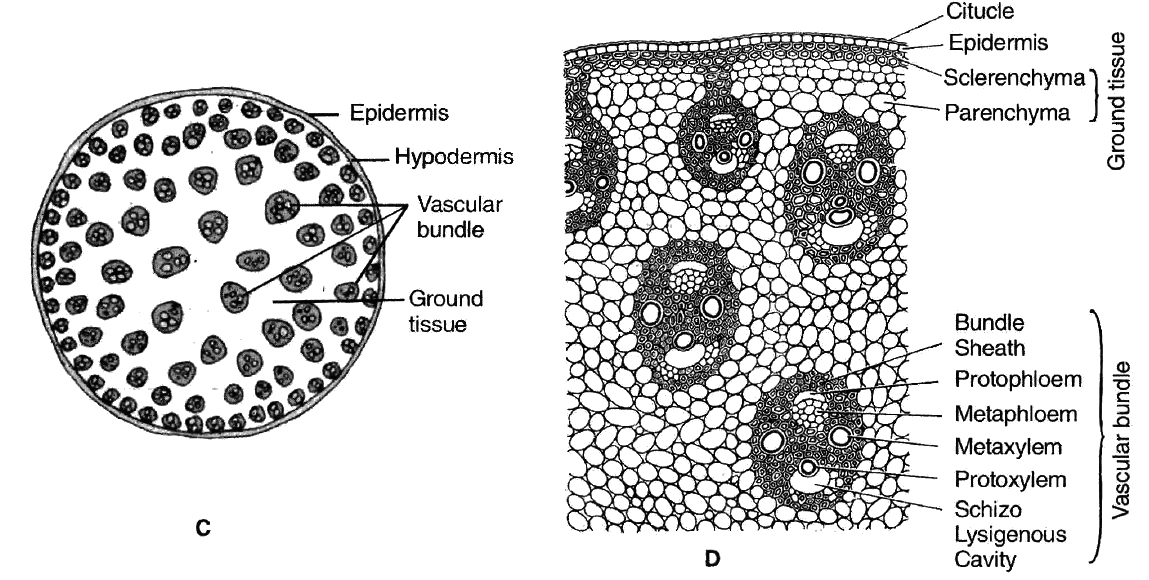
Part of transverse sections of stem: A-B. Dicot stem C-D. Monocot stem
2. Primary structure of monocot stem
Monocot stem consists of following layers:
(i) Epidermis: It is the outermost layer and consists of compactly arranged parenchyma cells which are usually covered with cuticle.
(ii) Hypodermis: Cells of hypodermis are sclerenchymatous, providing mechanical strength to the stem.
(iii) Ground tissue: All the tissues inner to hypodermis represents the ground tissue. It is made up of parenchymatous cells rich in food reserve, like starch.
(iv) Vascular bundles: They lie scattered in the ground tissue. Each vascular bundle is surrounded by 2 or 3 layered sclerenchymatous sheath called as bundle sheath. The vascular bundles are conjoint, colateral, closed and endarch (Atactostele). Vessels are arranged in V shaped manner. Schizolysigenous water cavity or canals are present below protoxylem.
Differences between dicot and monocot stem anatomy
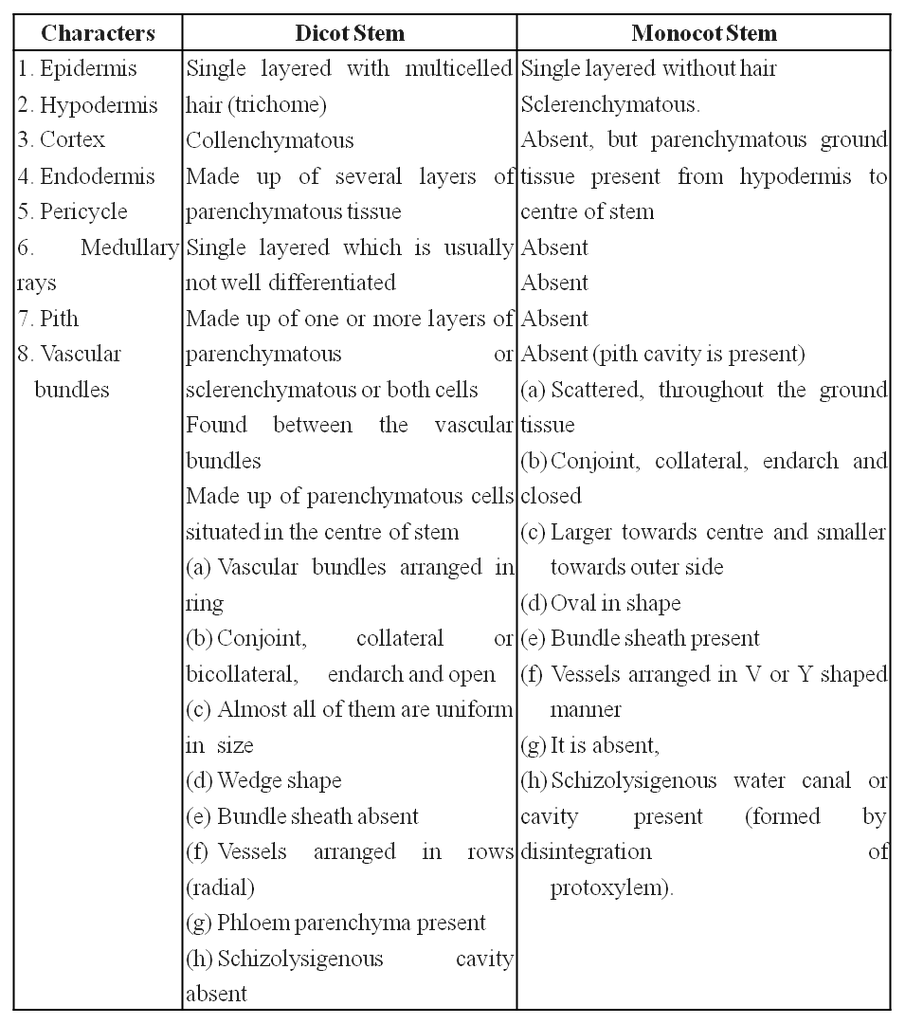
Anatomy of Leaf
1. Structure of dorsiventral leaf (dicot) :
In cross section of dicot leaf, following parts can be observed
(i) Epidermis.
The upper and lower surfaces are covered by the epidermis.
Cells of epidermis are parenchymatous and are closely packed together without any intercellular spaces.
Mostly the stomata are restricted to lower surface of leaf. Such leaves are called hypostomatic.
The outer walls of the epidermal cells are thickened and cutinized which prevents the loss of water.
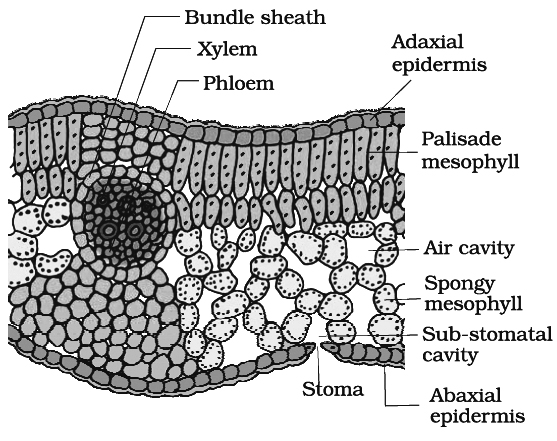
(ii) Mesophyll.
Between the two epidermal layers, there are numerous parenchyma cells which constitute the mesophyll.
In dicots, there are two distinct layers of mesophyll-the palisade (upper layer consisting of closely arranged column shaped cells containing abundant chloroplasts) and spongy tissue (the lower layer of irregularly shaped cells containing fewer chloroplasts).
(iii) Vascular bundles.
Vascular bundles in the leaf are located in the midrib and the veins.
Vascular bundles are conjoint, collateral and closed. Bundles are surrounded by a compact layer of parenchymatous cells which is called bundle sheath.
The xylem (protoxlem) is towards upper epidermis (adaxial) and the phloem on the lower epidermis (abaxial).
2. Structure of isobilateral leaf (monocot) :
Like the dicot leaf, it can also be differentiated into three types of tissues:
(i) Epidermis.
It consists of upper and lower epidermis, both of which may be interrupted by equal number of stomata.
Both the epidermal layers are cutinized. In some grasses e.g., Poa, Agropyron Maize, Psamma, epidermal cells are large with thin flexible walls which are called motor or bulliform cells.
These cells help in the rolling and unrolling of leaves.
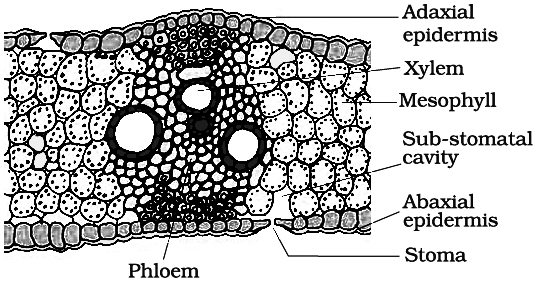
(ii) Mesophyll. Mesophyll cells are not differentiated into palisade and spongy parenchyma. Mesophyll cells are made up of parenchyma cells which have chloroplasts.
(iii) Vascular bundles. They are arranged in parallel manner. Vascular bundles are conjoint, collateral, closed and enclosed by a bundle sheath. The xylem is towards the upper side (adaxial surface) and phloem on the lower side (abaxial surface).
Anatomy of dicotyledonous and monocotyledonous plants
Transverse sections of the mature zones of roots, stems, and leaves are useful for better understanding the tissue organization of these organs.
A.Dicotyledonous Root: The interior tissue organization is as follows:
1. Epiblema is the outermost layer in the interior tissue architecture. Epiblema cells emerge as unicellular root hairs on many occasions.
2. The cortex is made up of many layers of parenchymal cells with thin walls and intercellular gaps.
3. Endodermis is the cortex's deepest layer. There are no intercellular gaps in the single layer of barrel-shaped cells.
4. Water-impermeable waxy substance suberin is deposited in the form of Casparian strips on the tangential as well as radial walls of endodermal cells.
5. A few layers of thick-walled parenchymatous cells called pericycle are found next to the endodermis. During secondary growth, these cells initiate the formation of lateral roots and vascular cambium.
6. The pith is small and undetectable.
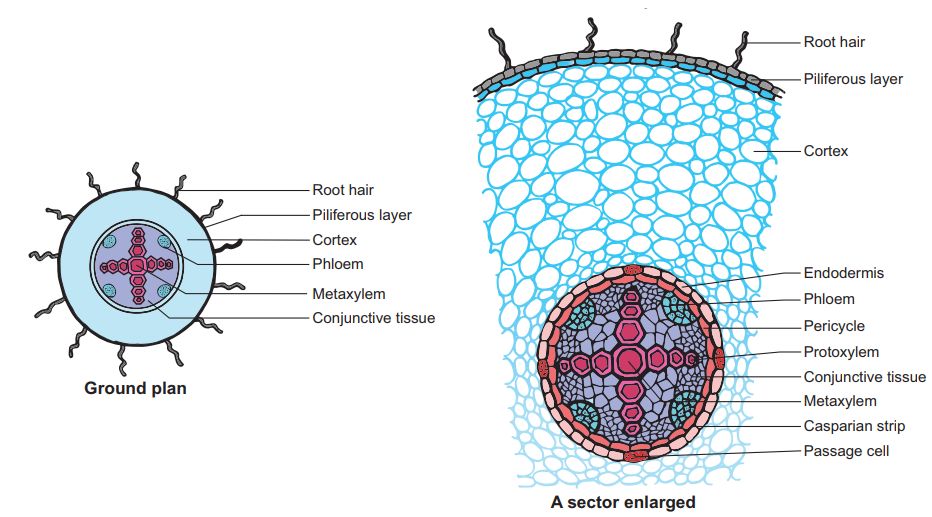
7. Conjuctive tissue is made up of parenchymatous cells that reside between the xylem and the phloem. Two to four xylem and phloem patches are typical. A cambium ring forms later between the xylem and the phloem.
8. The stele is made up of all tissues on the inner side of the endodermis, such as the pericycle, vascular bundles, and pith.
B. Monocotyledonous Root: In many ways, the monocot root's anatomy is identical to that of the dicot root.
1. Epidermis, cortex, endodermis, pericycle, vascular bundles, and pith are all present.
2. Unlike the dicot root, which has fewer xylem bundles, the monocot root frequently has more than six (polyarch) xylem bundles.
3. The pith is thick and developed.
4. There is no secondary development in monocotyledonous roots.
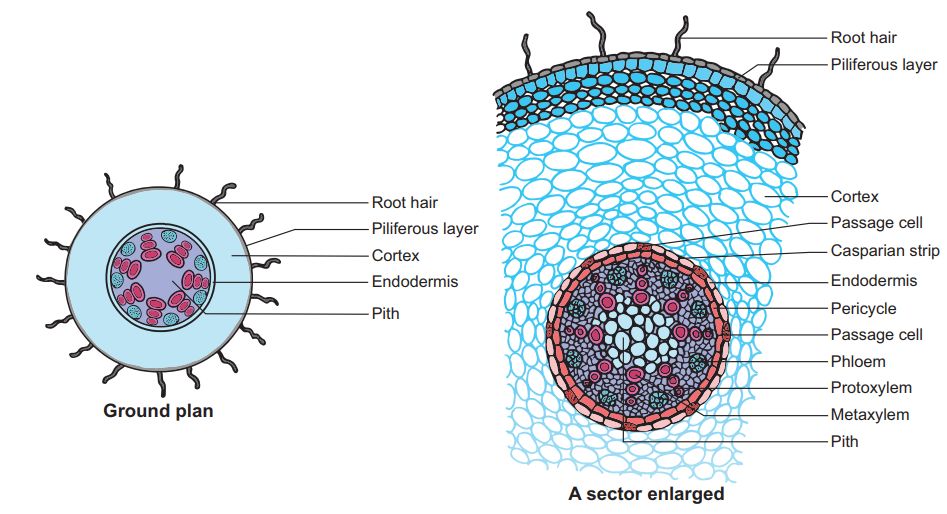
C. Dicotyledonous Stem:
1. The epidermis is the stem's outermost protective covering, as shown in this transverse section of a typical immature dicotyledonous stem.
2. It may have trichomes and a few stomata and is covered in a thin layer of cuticle.
3. The cortex is made up of cells organized in many layers between the epidermis and the pericycle. It is divided into three zones.
4. Just below the epidermis, the outer hypodermis consists of a few layers of collenchymatous cells that offer mechanical support to the embryonic stem.
5. The cortical layers underneath the hypodermis are made up of spherical parenchymatous cells with visible intercellular gaps.
6. The endodermis is the deepest layer andbecause the endodermis cells are densely packed with starch grains, the layer is also known as the starch sheath.
7. Pericycle appears as semi-lunar patches of sclerenchyma on the inner side of the endodermis and above the phloem.
8. Medullary rays are a few layers of radially arranged parenchymatous cells that lie between the vascular bundles.
9. A ring of vascular bundles surrounds the stem of a dicot. Each vascular bundle is joined, open, and has a protoxylem at the end.
10. The pith is made up of a large number of spherical, parenchymatous cells with extensive intercellular gaps that occupy the middle region of the stem.
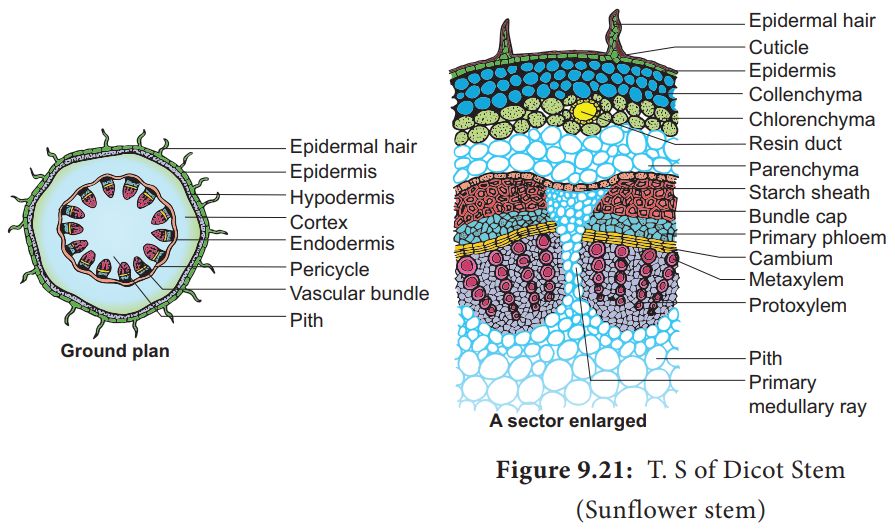
D. Monocotyledonous Stem:
1.A sclerenchymatous hypodermis, numerous distributed vascular bundles, each enclosed by a sclerenchymatous bundle sheath, and a broad, prominent parenchymatous ground tissue characterize the monocot stem.
2. The vascular bundles are joined and closed together. Vascular bundles at the periphery are typically smaller than those in the center.
3. The phloem parenchyma is missing, and there are water-filled holes inside the vascular bundles.
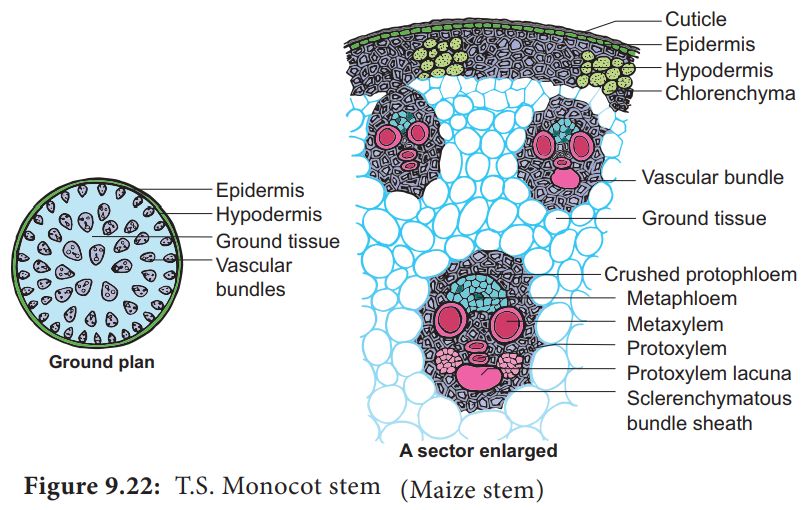
E. Dicotyledonous Leaf:
They are also called Dorsiventral Leaves.
1. The epidermis, mesophyll, and vascular system are visible in a vertical piece of a dorsiventral leaf through the lamina.
2. The epidermis of the leaf has a prominent cuticle that covers both the upper (adaxial epidermis) and bottom (abaxial epidermis).
3. In general, the abaxial epidermis has more stomata than the adaxial epidermis.
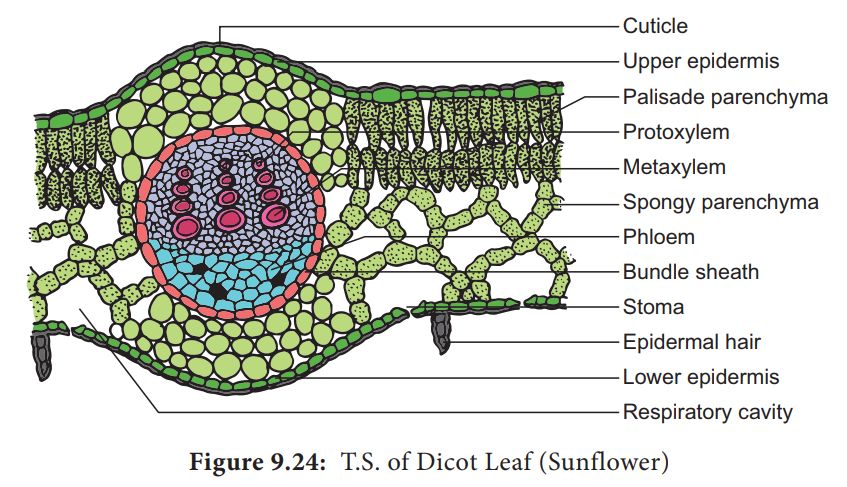
4. Stomata may even be absent in the upper epidermis. The mesophyll is the tissue that lies between the top and lower epidermis.
5. The mesophyll is made up of parenchyma, which contains chloroplasts and performs photosynthesis.
6. The palisade parenchyma and the spongy parenchyma are two types of cells. The elongated cells that make up the adaxial palisade hepatocytes are organized vertically and parallel to each other.
7. The spongy parenchyma, which is oval or spherical and loosely organized, is found underneath the palisade cells and reaches the lower epidermis. Between these cells are various huge gaps and air cavities.
8. Vascular bundles can be found in the veins and midrib of the vascular system. The size of the vascular bundles is determined by the vein size.
9. The veins in the dicot leaves' reticulate venation vary in thickness. A layer of thick-walled bundle sheath cells surrounds the vascular bundles.
F. Monocot Leaf:
They are also known as Isobilateral Leaves.In many ways, the anatomy of the isobilateral leaf is identical to that of the dorsiventral leaf. It demonstrates the following distinguishing characteristics.
1. Stomata are present on both epidermal surfaces in an isobilateral leaf, and the mesophyll is not divided into palisade and spongy parenchyma.
2. Certain adaxial epidermal cells along veins in grasses transform into huge, empty, colorless cells called Bulliform cells.
3. The leaf surface is exposed when the bulliform cells in the leaves have absorbed water and are turgid. They curl the leaves inwards to reduce water loss when they are flaccid due to water stress.
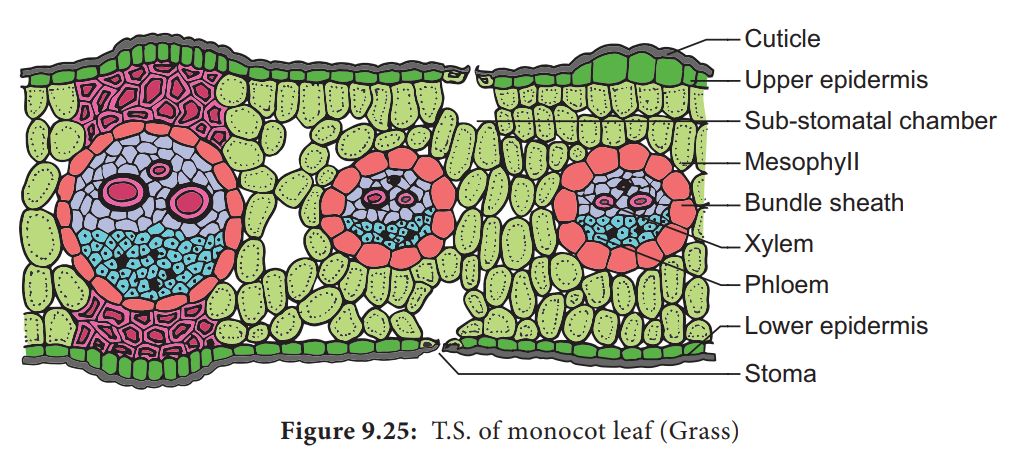
4. In vertical sections of monocot leaves, the parallel venation is represented in the near comparable diameters of vascular bundles.

 ACME SMART PUBLICATION
ACME SMART PUBLICATION
